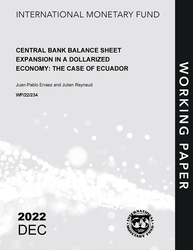
Central Bank Balance Sheet Expansion in a Dollarized Economy: The Case of Ecuador
Central Bank Balance Sheet Expansion in a Dollarized Economy: The Case of Ecuador
READ MORE...
Volume/Issue:
Volume 2022
Issue 234
Publication date: December 2022
ISBN: 9798400226793
$20.00
Add to Cart by clicking price of the language and format you'd like to purchase
Available Languages and Formats
| English |
Prices in red indicate formats that are not yet available but are forthcoming.
Topics covered in this book
This title contains information about the following subjects.
Click on a subject if you would like to see other titles with the same subjects.
Banks and Banking , Economics- Macroeconomics , Economics / General , Central bank , balance sheet expansion , fiscal dominance , central bank financing , financing of the government , accounting practice , liquidity ration , CBE balance sheet , CBE liability , International reserves , State-owned banks , Financial statements , Bank deposits , Public sector
Also of interest
Summary
A textbook argument in favor of adopting another country’s legal tender is that it imposes strong constraints on money creation and therefore fiscal dominance. In Ecuador, an officially dollarized economy since January 2000, a series of accounting practices and subsequent changes in legislations approved over the period 2009-2014 allowed an expansion of the Central Bank of Ecuador’s (CBE) balance sheet to finance the central government. At its peak, central bank financing of the government represented 10 percent of GDP. This resulted in large liabilities to the CBE that translated into low reserve coverage, putting the public and private financial systems and ultimately the dollarization regime at risk. In this paper, we first present the legal and accounting processes behind the expansion of the CBE's balance sheet and some stylized facts. In the second section, we establish a stress test-like methodology to show how the expansion of the CBE’s balance sheet induced strong pressures on CBE’s liquidity. Ultimately, such liquidity stress at the CBE translated into high cash inflows needs, i.e. external debt, for the central government.
Copyright © 2010 - 2025
Powered by:
AIDC



